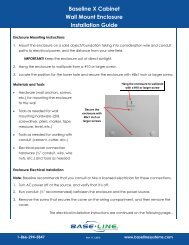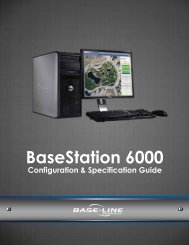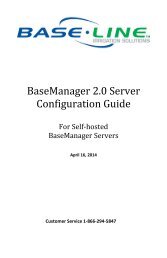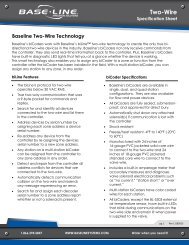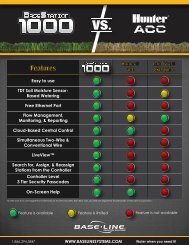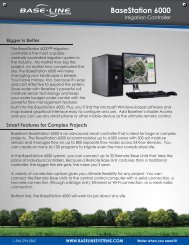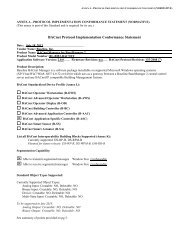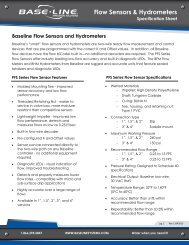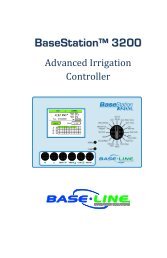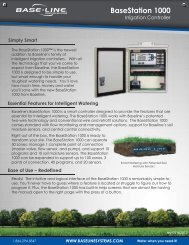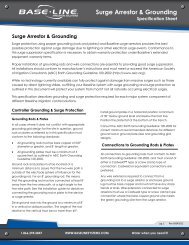BaseStation 3200 User Manual â 11.7.5.15 ... - Baseline Systems
BaseStation 3200 User Manual â 11.7.5.15 ... - Baseline Systems
BaseStation 3200 User Manual â 11.7.5.15 ... - Baseline Systems
You also want an ePaper? Increase the reach of your titles
YUMPU automatically turns print PDFs into web optimized ePapers that Google loves.
<strong>BaseStation</strong> <strong>3200</strong> Advanced Irrigation Controller <strong>Manual</strong><br />
5. Assign the biCoder as a pause device, and test its operation. Refer to Configuring Pause Devices on page 40.<br />
Wiring a Rain Switch and Other Normally Closed Sensing Devices<br />
All <strong>BaseStation</strong> <strong>3200</strong> controllers are compatible with industry standard normally closed (NC) sensing devices such<br />
as rain switches. You can directly connect these devices to the appropriate terminals on the <strong>3200</strong>, or you can<br />
connect them to the two-wire path using pause biCoders.<br />
Connecting a Rain Switch to the <strong>BaseStation</strong> <strong>3200</strong><br />
Note: Do not wire normally closed sensing devices in series with either the valve common (on R-series units) or<br />
either side of the two-wire path. Wiring devices in this manner defeats the wire health and solenoid current<br />
detection features built into the controller. It also generates incorrect messages and alerts. <strong>Baseline</strong> recommends<br />
that you connect all normally closed sensing devices to the appropriate terminal on the controller or to a pause<br />
biCoder connected to the two-wire path.<br />
Pause Behavior for the Different Connections<br />
The pause behavior of the unit and the associated messages and alerts differ depending on whether the NC device<br />
is connected to a pause biCoder or it is directly connected to a sensor terminal on the <strong>3200</strong>.<br />
• You cannot override a NC sensing device, such as a rain switch, that is directly connected to the <strong>3200</strong>. All<br />
programs will stop watering until the rain switch dries out, which allows the contacts to close again.<br />
• You can connect pause devices, including rain switches, to pause biCoders, and then associate the pause<br />
biCoders with specific programs. After you have created the associations, you can configure the programs to<br />
respond to or ignore the pause devices. Refer to Configuring Pause Devices on page 40.<br />
Watering Behavior for the Different Ports<br />
Rain Sensor Port – On activation, all watering is stopped, and all active programs are terminated. No new irrigation<br />
will be allowed to start until the rain switch deactivates (dries out) and the next start time is reached for a<br />
program. <strong>Baseline</strong> recommends that rain switches connected this way are set to the shortest possible delay<br />
setting.<br />
Note: Smart irrigation using soil moisture sensors will automatically account for the amount of rainfall that actually<br />
penetrates into the soil, which is often quite different from the amount of total rainfall measured by a rain switch.<br />
Flow Sensor Port – On activation, all watering is stopped, and all active programs are terminated. No new<br />
irrigation will be allowed to start until the following conditions are met:<br />
• The flow sensor input is cleared (no longer open)<br />
• The flow alert is cleared in the controller. The flow alert can be cleared remotely using BaseManager central<br />
control, but requires user intervention to protect against landscape damage caused by broken pipes or valves.<br />
• The next start time is reached for a program<br />
Pause Port – On each activation (open circuit), all irrigation is temporarily paused for 4 hours. All active programs<br />
and scheduled watering will resume (where it left off) after the pause period has ended. If the pause port is<br />
activated again during the pause period, the 4 hour pause period will be restarted.<br />
Page 31



